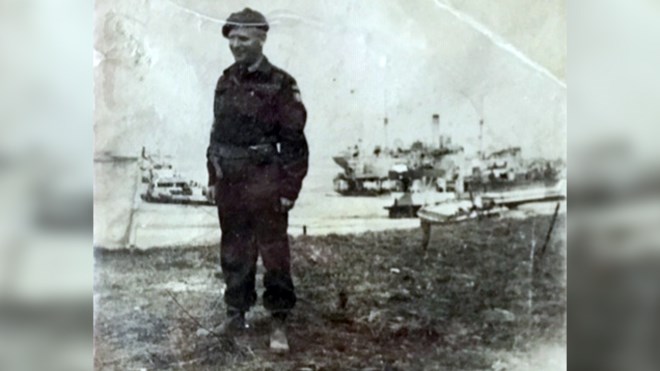By Dieter K. Buse
Crucial to the “necessary” war, as one historian has termed the Second World War, was the largest ever amphibious military expedition that took place on June 6, 1944, or D-Day. Many of the Canadian soldiers landing on Juno Beach in France with the British and Americans were from northeastern Ontario.
Some like Isadore Wemigwams of Wikwemikong remembered that his unit was “the last to get out of that hole.” Though scared and scarred, he survived.
William Davidson from Sudbury was among the first to get his tank on land and happy that he could successfully move off the beach. He too survived.
Now mostly forgotten, but known soon after the event because local papers reported on the successful invasion, was the role of Captain Art Cressey of Sudbury. He had been assigned to a special British unit that for two years planned and practiced the assault.
His official title was Movement Officer which meant he and others developed the timetables for when and where each platoon of men, each group of tanks, each batch of equipment and ammunition would arrive, unload and where it was to go.
The plan nearly went awry because Cressey was to be with the first landing craft and start directing the traffic of thousands coming off the landing barges. Due to rough sea his craft was the second, but the unloading proceeded efficiently and according to plan. There is a blurry photo of Cressey standing on a rise overseeing what must have seemed like an anthill of activity below him.
Not so lucky were the following who all landed on June 6, 1944: Corporal Hugh Rocks of Kirkland Lake died in the first assault that day. Rifleman John (Jack) Richard Hastie (B65578) from Manitoulin was killed on June 11, 1944, as was Gordon Joseph Hogan (B134998) from North Bay.
Arriving at Normandy a month later was the Algonquin Regiment, the only formation from northeastern Ontario not to be broken up and distributed among units identified with other places in Ontario or Canada. Headquartered in North Bay, and comprised initially of men from Parry Sound to South Porcupine, from Mattawa to Sudbury, it fought from just north of Juno Beach through France and Belgium and decisively helped in the liberation of the Netherlands.
Plaques there acknowledge the regiment’s efforts and many graves in the cemeteries attest to their sacrifice. It must be remembered that D-Day was the beginning of the year during which more soldiers died than in the previous five, for example more than 50 from Kirkland Lake and 14 from Kapuskasing. The honour rolls keeping track of the mounting deaths show that for a large company like Inco more than two-thirds of its 153 employees who died in the war, died in the year after D-Day.
D-Day should be remembered, but also to be remembered is that Northeasterners participated, contributed and sacrificed. Just as some Americans and Brits write about this event as though they were the only ones there, Canadian military historians mostly overlook who specifically was there from various parts of Canada.
Dr. Dieter K. Buse is Professor Emeritus of History at Laurentian University, and the co-author with Graeme S. Mount of Come on Over: Northeastern Ontario (2011) and Untold: Northeastern Ontario’s Military Past. The book Untold: Northeastern Ontario’s Military Past, vol 1: 1662-World War I (published October 2018 by Latitude46), demonstrated the important contributions of men and women from our region to the military efforts of Canada. The next volume, which will cover from 1919 through peacekeeping, focuses mainly on World War II, and will appear this October.
